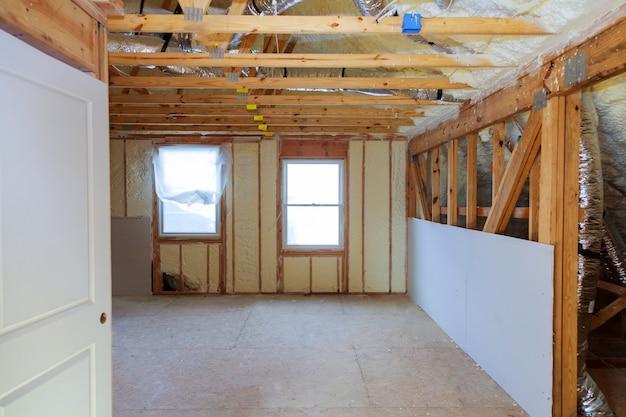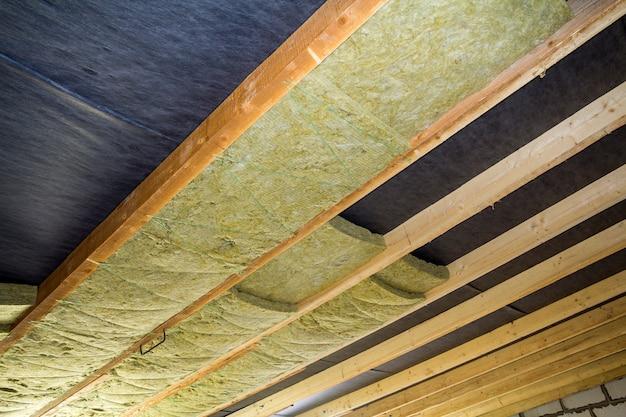When it comes to insulating your home, knowing which direction to face your insulation can make a big difference in its effectiveness. It’s a common question many homeowners have: Should the paper side face in or out, or does it even matter? In this blog post, we’ll dive into the ins and outs of insulation placement, shedding light on the importance of facing and vapor barriers. By the end, you’ll have a clear understanding of how to optimize your home’s insulation for maximum energy efficiency and comfort.
Insulation is designed to resist the flow of heat, keeping your home warm in the winter and cool in the summer. However, without proper installation, insulation can fall short in achieving its intended purpose. That’s where knowing which way it should face comes into play. But before we delve into that, let’s first address the concept of a vapor barrier. Is it the same as the paper backing on insulation? And do you need one? These are important questions that we’ll tackle in this post, ensuring you have all the information you need to insulate your home properly. So, let’s get started!

Which Way Should Insulation Face?
Have you ever wondered which way your insulation should face? It may not be a burning question that keeps you up at night, but knowing the correct direction can make a big difference in the effectiveness of your insulation. In this subsection, we’ll delve into the topic of which way insulation should face and uncover the secrets behind optimal insulation placement.
The Basics of Insulation
Before we dive into the direction, let’s brush up on the basics of insulation. Insulation is like a cozy blanket for your home, keeping you warm in the winter and cool in the summer. It helps to regulate the temperature inside by resisting the transfer of heat between the interior and exterior of your house. Choosing the right insulation material is important, but so is its installation, including the direction it faces.
Facing the Heat
When it comes to insulation, the direction it faces can impact its ability to resist heat flow. Most insulation materials have a vapor barrier, typically made of foil or plastic, on one side. This barrier helps to control the movement of moisture and prevent it from seeping into your walls. But what about heat?
Cold Climates: Face the Heat Inward
If you live in a cold climate, such as snowy New England or the frosty Midwest, it’s best to face the vapor barrier towards the interior of your home. This direction helps to keep warm air inside, preventing it from escaping and mingling with the cold air outside. By trapping the heat indoors, your insulation will work more effectively, resulting in lower energy bills and a cozier living space.
Warm Climates: Face the Heat Outward
On the flip side, if you reside in a warm climate like sunny Florida or the scorching desert Southwest, you’ll want to face the vapor barrier outward. This placement allows the insulation to reflect the heat away from your home, keeping it cooler inside. By preventing the hot air from penetrating your walls, your air conditioner won’t have to work as hard to maintain a comfortable temperature, saving you moola on your energy bill.
Mixing It Up in Moderate Climates
Now, what if you’re lucky enough to live in a moderate climate where the seasons aren’t extreme? You might find yourself asking, “Which way should I face my insulation?” In these regions, it’s best to strike a balance. To enjoy the benefits of both worlds, you can use a combination of insulation types. For example, you can use inward-facing insulation on the walls that face the colder side, and outward-facing insulation on the walls that face the sunnier side. This approach ensures that your home remains cozy in the winter and cool in the summer.
In conclusion, the direction in which your insulation faces can significantly impact its effectiveness. Cold climates call for an inward-facing vapor barrier to retain heat, while warm climates benefit from an outward-facing barrier to repel heat. In moderate climates, a combination of insulation types can be used to optimize energy efficiency. So, the next time you’re installing or replacing insulation, remember to consider your climate and choose the right direction for your insulation. Stay snug or cool, my friends!

FAQ: Which Way Should Insulation Face?
Which Way Does Insulation Go in an Attic
When insulating your attic, it’s essential to know which way the insulation should face. To maximize its effectiveness, insulation should be installed with the paper facing toward the living space. This helps create an effective thermal barrier by preventing heat from escaping or entering your home.
Is the Paper on Insulation a Vapor Barrier
The paper on insulation serves as both a vapor retarder and a facing material. It helps to control the movement of moisture through the insulation, preventing condensation from forming and protecting your home from potential damage. However, it’s important to note that the paper facing alone may not provide sufficient vapor barrier properties in all cases.
Which Way Should Insulation Face in the Basement
In basements, insulation should be installed with the paper facing toward the heated living space. This helps to retain the warmth inside your home and minimize heat loss through the basement walls. By properly insulating your basement, you can create a more comfortable and energy-efficient living environment.
What Is the Purpose of Paper Backing on Insulation
The paper backing on insulation serves several purposes. It acts as a vapor retarder, helps improve the insulation’s thermal performance, and provides a convenient way to attach the insulation to framing or other surfaces. Additionally, the paper facing often includes markings or instructions to guide proper installation.
What Is the Best Way to Insulate a Basement Ceiling
Insulating a basement ceiling can help reduce heat transfer between the basement and the upper floors of your home. For this application, it is recommended to use insulation without a facing material. Unfaced insulation allows for better air circulation within the joist spaces and prevents potential moisture buildup.
Can I Use Tyvek Tape for Vapor Barrier
Tyvek tape is commonly used as a weather-resistant barrier, but it may not be suitable for use as a vapor barrier on insulation. It is essential to use tape specifically designed for vapor barriers to ensure proper sealing and to maintain the integrity of the insulation system.
Is It Better to Use Faced or Unfaced Insulation
The choice between faced and unfaced insulation depends on the specific application. Faced insulation, with its paper backing, is commonly used in walls and attics to act as a vapor retarder. Unfaced insulation is preferred for areas where a vapor barrier is unnecessary or additional vapor control measures are in place.
Should You Tape Insulation Seams
Taping insulation seams is a recommended practice to create a continuous vapor barrier and enhance the overall performance of the insulation system. Using appropriate tape ensures proper sealing and helps prevent air and moisture infiltration, maximizing the insulation’s efficiency.
Can You Install Insulation Horizontally
Yes, insulation can be installed horizontally, especially in areas like walls or basement ceilings. Horizontal installation helps ensure a snug fit and minimizes gaps and voids. Remember to snugly fit the insulation and avoid compressing it, as this can reduce its effectiveness.
Does It Matter Which Way Insulation Is Installed
Yes, it does matter which way insulation is installed. The paper facing should always face the warm side of the insulated space. This helps to create a barrier that prevents heat transfer, keeping your home cozy during the winter and reducing energy consumption.
Should Insulation Be Stapled to Studs
Stapling insulation to studs can help secure it in place and prevent it from sagging or shifting over time. However, it’s important to use appropriate fasteners and techniques to avoid compressing the insulation, which can reduce its effectiveness. Consult installation guidelines for specific recommendations.
Which Side Is the Vapor Barrier on Insulation
The vapor barrier is typically located on the side of insulation facing the heated living space. This helps to prevent moisture from entering the insulation, minimizing the risk of condensation and potential damage to the structure. Always ensure correct installation to maintain the vapor barrier’s effectiveness.
Do I Want Faced or Unfaced Insulation
The choice between faced and unfaced insulation will depend on your specific needs. Faced insulation is ideal for applications where a vapor barrier is required, such as attics or exterior walls. Unfaced insulation is suitable for areas where moisture control is not a concern or when additional vapor barrier measures are in place.
Does It Matter If Insulation Is Installed Upside Down
Yes, it matters if insulation is installed upside down. The proper orientation ensures that the vapor barrier is correctly positioned toward the warm side of the insulated space. Installing insulation upside down can compromise its thermal performance and may lead to moisture-related issues.
Do I Need a Vapor Barrier If I Use Faced Insulation
In most cases, faced insulation with a proper vapor retarder acts as a sufficient vapor barrier. However, for highly humid environments or specialized applications, additional vapor barrier measures may be necessary. Consulting with a professional or following local building codes and regulations is recommended.
Can I Run Insulation Perpendicular to Joists
Yes, running insulation perpendicular to joists is a common practice. It allows for better coverage and helps minimize thermal bridging, the transfer of heat through the joists. Remember to cut insulation accurately to fit snugly between the joists and avoid compressing it to maintain its insulating properties.
Which Side of Insulation Board Faces Out
For insulation boards, the side with the reflective or radiant barrier typically faces outward. This side reflects heat rather than absorbing it, helping to keep your home cool in hot climates. Following manufacturer guidelines and instructions ensures proper installation for optimal performance.
Does It Matter If Insulation Is Faced
Yes, it matters if insulation is faced. The facing material plays a crucial role in managing moisture and acting as a vapor retarder. Proper facing orientation ensures effective heat flow control, prevents condensation, and maintains the insulation’s thermal performance. Follow guidelines to ensure correct installation.
Should Attic Insulation Be Faced or Unfaced
Attic insulation is typically faced to act as a vapor retarder and prevent moisture from migrating through the insulation. The facing material also provides support and ease of installation. However, local climate conditions and building codes might dictate specific requirements, so consulting with professionals is advised.
What Kind of Tape Do You Use on Insulation
For sealing insulation seams, it is recommended to use tape specifically designed for insulation purposes. Foil tape or polyethylene tape is commonly used as they provide proper adhesion, durability, and compatibility with insulation materials. Ensure to follow manufacturer instructions for best results.
Should I Put Plastic Over Insulation Before Drywall
In general, it is not necessary to put plastic over insulation before drywall installation. The purpose of the vapor barrier is typically fulfilled by the facing material on the insulation. Introducing additional layers of plastic can potentially trap moisture and compromise the effectiveness of the insulation system. Consult local building codes for specific requirements.
In conclusion, understanding the correct orientation and installation techniques for insulation is crucial to optimize its efficiency and improve energy usage in our homes. By following these FAQs, you’ll be well-equipped to tackle your insulation projects and create a comfortable, energy-efficient living space. So go ahead, face your insulation with confidence – and enjoy the cozy benefits!